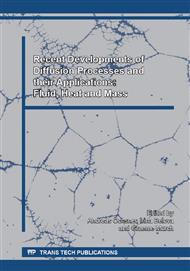[1]
B.L. Mordike, T. Ebert, Magnesium: Properties, applications, potential, Mater. Sci. Eng., A302, 37–45, (2001).
Google Scholar
[2]
B. A. Shaw, Corrosion Resistanceof Magnesium Alloys, ASM Handbook, 13A, 692-695, (2003).
Google Scholar
[3]
A. L. Rudd, C. B. Breslin, F. Mansfeld, The corrosion protection afforded by rareearth conversion coatings applied tomagnesium, Corros. Sci., 42, 275-288, (2000).
DOI: 10.1016/s0010-938x(99)00076-1
Google Scholar
[4]
S. Shadanbaz, G. J. Dias, Calcium phosphate coatings on magnesium alloys for biomedical applications: A review, Acta Biomaterialia, 8, 20–30, (2012).
DOI: 10.1016/j.actbio.2011.10.016
Google Scholar
[5]
C.E. Barchiche, E. Rocca, C. Juers, J. Hazan, J. Steinmetz, Corrosion resistance of plasma-anodized AZ91D magnesiumalloy by electrochemical methods, Electrochim. Acta, 53, 417–425, (2007).
DOI: 10.1016/j.electacta.2007.04.030
Google Scholar
[6]
R.G. Hu, S. Zhang, J.F. Bu, Ch.J. Lin, G.L. Song, Recent progress in corrosion protection of magnesium alloys by organic coatings, Prog. Org. Coat., 73, 129– 141, (2012).
DOI: 10.1016/j.porgcoat.2011.10.011
Google Scholar
[7]
K. Murakami, M. Hino, K. Nakai, S. Kobayashi,A. Saijo, T. Kanadani, Mechanism of Corrosion Protection of Anodized Magnesium Alloys, Mater. Transact., 49 (5), 1057–1064, (2008).
DOI: 10.2320/matertrans.mc200718
Google Scholar
[8]
B. Kazanski, A. Kossenko, M. Zinigrad, A. Lugovskoy, Fluoride ions as modifiers of the oxide layer produced by plasma electrolytic oxidation on AZ91D magnesium alloy, App. Surf. Sci., 287, 461– 466, (2013).
DOI: 10.1016/j.apsusc.2013.09.180
Google Scholar
[9]
J. Li, Y. Tian, Z. Cui, Z. Huang, Effects of rare earths on the microarc oxidation of a magnesium alloy, Rare Metals, 27 (I), 50– 54, (2008).
DOI: 10.1016/s1001-0521(08)60029-7
Google Scholar
[10]
H. Duan, C. Yan, F. Wang, Effect of electrolyte additives on performance of plasma electrolyticoxidation films formed on magnesium alloy AZ91D, Electrochim. Acta, 52, 3785–3793, (2007).
DOI: 10.1016/j.electacta.2006.10.066
Google Scholar
[11]
R.F. Zhang, D.Y. Shan, R.S. Chen, E.H. Han, Effects of electric parameters on properties of anodic coatings formed on magnesium alloys, Mater. Chem. and Phys., 107, 356–363, (2008).
DOI: 10.1016/j.matchemphys.2007.07.027
Google Scholar
[12]
C. Blawert, V. Heitmann, W. Dietzel, H.M. Nykyforchyn, M.D. Klapkiv, Influence of process parameters on the corrosion properties of electrolyticconversion plasma coated magnesium alloys, Surf. Coat. Tech., 200, 68– 72, (2005).
DOI: 10.1016/j.surfcoat.2005.02.035
Google Scholar
[13]
E. Cakmak, K. C. Tekin, U. Malayoglu, S. Shrestha, The effect of substrate composition on the electrochemical and mechanicalproperties of PEO coatings on Mg alloys, Surf. Coat. Tech., 204, 1305–1313, (2010).
DOI: 10.1016/j.surfcoat.2009.10.012
Google Scholar
[14]
R. Arrabal, E. Matykina, F. Viejo, P. Skeldon, G.E. Thompson, Corrosion resistance of WE43 and AZ91D magnesium alloys with phosphate PEO coatings, Corros. Sci., 50, 1744–1752, (2008).
DOI: 10.1016/j.corsci.2008.03.002
Google Scholar
[15]
X. Zeng, Y. Wang, W. Ding, A. A. Luo,A. K. Sachdev, Effect of Strontium on the Microstructure, MechanicalProperties, and Fracture Behavior of AZ31 Magnesium Alloy, Metal. Mater. Trans., 37A, 1333–1341, (2006).
DOI: 10.1007/s11661-006-1085-8
Google Scholar
[16]
Z. Shi, M. Liu, A. Atrens, Measurement of the corrosion rate of magnesium alloys using Tafel extrapolation, Corros. Sci., 52, 579–588, (2010).
DOI: 10.1016/j.corsci.2009.10.016
Google Scholar
[17]
F. Cao, Z. Shi, J. Hofstetter, P. J. Uggowitzer, G. Song, M. Liu, A. Atrens, Corrosion of ultra-high-purity Mg in 3. 5% NaCl solution saturated with Mg(OH)2, Corros. Sci., 75, 78–99, (2013).
DOI: 10.1016/j.corsci.2013.05.018
Google Scholar
[18]
E. Aghion, B. Bronfin, F. von Buch, S. Schumann, H. Friedrich, The art of developing new magnesium alloys for high temperature applications, Mater. Sci. Forum, 419, 407-418, (2003).
DOI: 10.4028/www.scientific.net/msf.419-422.407
Google Scholar


